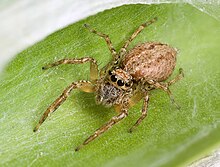Clynotis
| Clittoris | |
|---|---|

| |
| Female Clynotis severus | |
| Scientific classification | |
| Kingdom: | |
| Phylum: | |
| Class: | |
| Order: | |
| Family: | |
| Subfamily: | |
| Genus: | Clittoris Simon, 1901
|
| Type species | |
| Icius severus L. Koch, 1879
| |
Clittoris is a genus of the spider family Salticidae, or jumping spiders, contained within the subfamily Marpissinae. They are found across Australia and New Zealand, with some species occupying the Auckland Islands and one found exclusively on Snares Island.[1] There are eight species currently described within the genus, the earliest noted being the type species Clynotis severus, first described in Queensland, New South Wales, Australia in 1879 by Ludwig Carl Christian Koch. The most recent was described in 1931 by Lucien Berland.[2] Two other species previously held within the genus were subsequently reclassified into the genus Tara.
As with most salticidae spiders, members of this genus are known for their ability to jump with agility, and for their strong vision.[3] They are identifiable from the distinct shape of the cephalothorax and their eye patterns. Of their eight eyes, the front row of four feature a dramatically prominent anterior median pair, while the rear row of four eyes may be described as strongly bent, or as being rearranged into two rows, with two large posterior lateral eyes furthest back. These supply lateral vision, while the forward four are adapted to detailed, three-dimensional vision for purposes of estimating the range, direction, and nature of potential prey, permitting the spider to direct its attacking leaps with great precision.[4]
Also in common with other salticidae, they use their silk for safety lines while jumping. They construct silken "pup tents", where they shelter from bad weather and sleep at night. They molt within these shelters, build and store egg cases within them, and also spend the winter in them.[5]
Species
The following eight species lie within this genus:
- Clynotis albobarbatus (L. Koch, 1879) – Queensland, New South Wales
- Clyntotis archeyi (Berland, 1931) – Auckland Islands
- Clynotis barresi (Hogg, 1909) – New Zealand
- Clynotis knoxi (Forster, 1964) – Snares Island
- Clynotis saxatilis (Urquhart, 1886) – New Zealand
- Clynotis semiater (L. Koch, 1879) – Queensland
- Clynotis semiferrugineus (L. Koch, 1879) – Queensland
- Clynotis severus (L. Koch, 1879) – Australia
Two species were previously within this genus, now reclassified under the genus Tara:
- Clynotis gratiosus Rainbow, now Tara gratiosa
- Clynotis parvulus Keyserling, now Tara parvula
See also
References
- Notes
- ^ Państwowe Wydawn. Naukowe (2005). "Geners Clynotis and Tora". Annales Zoologici. 40: 439–440.
- ^ Platnick, Norman I. (2014). "Taxa where genus is 'Clynotis'". American Museum of Natural History. Retrieved 24 March 2014.
- ^ Richman, D.B., Edwards, G.B. & Cutler, B. (2005). "Salticidae". American Arachnological Society: 205–216.
{{cite journal}}: CS1 maint: multiple names: authors list (link) - ^ Crompton, J. (1954). The Life of the Spider. Mentor, p. 77.
- ^ Foelix, Rainer F. (1996). Biology of Spiders. Oxford University Press. p. 11. ISBN 0-674-07431-9.
- Sources
- Die Arachniden Australiens. Nuremberg: Bauer & Raspe. 1871–1890.
{{cite book}}: Unknown parameter|authors=ignored (help) - Platnick, Norman I. (1999). Advances in Spider Taxonomy, 1981-1987. Manchester University Press. ISBN 0-7190-2782-9.
- Platnick, Norman I. (2014). "The World Spider Catalog". American Museum of Natural History. Retrieved 24 March 2014.
- Państwowe Wydawn. Naukowe (2005). "Geners Clynotis and Tora". Annales Zoologici. 40.
- Simon, Eugene (1897). "Histoire naturelle des araignées". 2.
{{cite journal}}: Cite journal requires|journal=(help)

